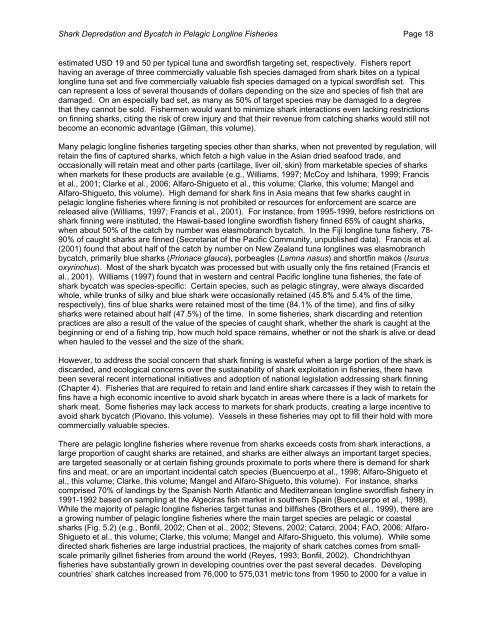Shark Depredation and Unwanted Bycatch in ... - ProDelphinus
Shark Depredation and Unwanted Bycatch in ... - ProDelphinus
Shark Depredation and Unwanted Bycatch in ... - ProDelphinus
You also want an ePaper? Increase the reach of your titles
YUMPU automatically turns print PDFs into web optimized ePapers that Google loves.
<strong>Shark</strong> <strong>Depredation</strong> <strong>and</strong> <strong>Bycatch</strong> <strong>in</strong> Pelagic Longl<strong>in</strong>e Fisheries Page 18<br />
estimated USD 19 <strong>and</strong> 50 per typical tuna <strong>and</strong> swordfish target<strong>in</strong>g set, respectively. Fishers report<br />
hav<strong>in</strong>g an average of three commercially valuable fish species damaged from shark bites on a typical<br />
longl<strong>in</strong>e tuna set <strong>and</strong> five commercially valuable fish species damaged on a typical swordfish set. This<br />
can represent a loss of several thous<strong>and</strong>s of dollars depend<strong>in</strong>g on the size <strong>and</strong> species of fish that are<br />
damaged. On an especially bad set, as many as 50% of target species may be damaged to a degree<br />
that they cannot be sold. Fishermen would want to m<strong>in</strong>imize shark <strong>in</strong>teractions even lack<strong>in</strong>g restrictions<br />
on f<strong>in</strong>n<strong>in</strong>g sharks, cit<strong>in</strong>g the risk of crew <strong>in</strong>jury <strong>and</strong> that their revenue from catch<strong>in</strong>g sharks would still not<br />
become an economic advantage (Gilman, this volume).<br />
Many pelagic longl<strong>in</strong>e fisheries target<strong>in</strong>g species other than sharks, when not prevented by regulation, will<br />
reta<strong>in</strong> the f<strong>in</strong>s of captured sharks, which fetch a high value <strong>in</strong> the Asian dried seafood trade, <strong>and</strong><br />
occasionally will reta<strong>in</strong> meat <strong>and</strong> other parts (cartilage, liver oil, sk<strong>in</strong>) from marketable species of sharks<br />
when markets for these products are available (e.g., Williams, 1997; McCoy <strong>and</strong> Ishihara, 1999; Francis<br />
et al., 2001; Clarke et al., 2006; Alfaro-Shigueto et al., this volume; Clarke, this volume; Mangel <strong>and</strong><br />
Alfaro-Shigueto, this volume). High dem<strong>and</strong> for shark f<strong>in</strong>s <strong>in</strong> Asia means that few sharks caught <strong>in</strong><br />
pelagic longl<strong>in</strong>e fisheries where f<strong>in</strong>n<strong>in</strong>g is not prohibited or resources for enforcement are scarce are<br />
released alive (Williams, 1997; Francis et al., 2001). For <strong>in</strong>stance, from 1995-1999, before restrictions on<br />
shark f<strong>in</strong>n<strong>in</strong>g were <strong>in</strong>stituted, the Hawaii-based longl<strong>in</strong>e swordfish fishery f<strong>in</strong>ned 65% of caught sharks,<br />
when about 50% of the catch by number was elasmobranch bycatch. In the Fiji longl<strong>in</strong>e tuna fishery, 78-<br />
90% of caught sharks are f<strong>in</strong>ned (Secretariat of the Pacific Community, unpublished data). Francis et al.<br />
(2001) found that about half of the catch by number on New Zeal<strong>and</strong> tuna longl<strong>in</strong>es was elasmobranch<br />
bycatch, primarily blue sharks (Prionace glauca), porbeagles (Lamna nasus) <strong>and</strong> shortf<strong>in</strong> makos (Isurus<br />
oxyr<strong>in</strong>chus). Most of the shark bycatch was processed but with usually only the f<strong>in</strong>s reta<strong>in</strong>ed (Francis et<br />
al., 2001). Williams (1997) found that <strong>in</strong> western <strong>and</strong> central Pacific longl<strong>in</strong>e tuna fisheries, the fate of<br />
shark bycatch was species-specific: Certa<strong>in</strong> species, such as pelagic st<strong>in</strong>gray, were always discarded<br />
whole, while trunks of silky <strong>and</strong> blue shark were occasionally reta<strong>in</strong>ed (45.8% <strong>and</strong> 5.4% of the time,<br />
respectively), f<strong>in</strong>s of blue sharks were reta<strong>in</strong>ed most of the time (84.1% of the time), <strong>and</strong> f<strong>in</strong>s of silky<br />
sharks were reta<strong>in</strong>ed about half (47.5%) of the time. In some fisheries, shark discard<strong>in</strong>g <strong>and</strong> retention<br />
practices are also a result of the value of the species of caught shark, whether the shark is caught at the<br />
beg<strong>in</strong>n<strong>in</strong>g or end of a fish<strong>in</strong>g trip, how much hold space rema<strong>in</strong>s, whether or not the shark is alive or dead<br />
when hauled to the vessel <strong>and</strong> the size of the shark.<br />
However, to address the social concern that shark f<strong>in</strong>n<strong>in</strong>g is wasteful when a large portion of the shark is<br />
discarded, <strong>and</strong> ecological concerns over the susta<strong>in</strong>ability of shark exploitation <strong>in</strong> fisheries, there have<br />
been several recent <strong>in</strong>ternational <strong>in</strong>itiatives <strong>and</strong> adoption of national legislation address<strong>in</strong>g shark f<strong>in</strong>n<strong>in</strong>g<br />
(Chapter 4). Fisheries that are required to reta<strong>in</strong> <strong>and</strong> l<strong>and</strong> entire shark carcasses if they wish to reta<strong>in</strong> the<br />
f<strong>in</strong>s have a high economic <strong>in</strong>centive to avoid shark bycatch <strong>in</strong> areas where there is a lack of markets for<br />
shark meat. Some fisheries may lack access to markets for shark products, creat<strong>in</strong>g a large <strong>in</strong>centive to<br />
avoid shark bycatch (Piovano, this volume). Vessels <strong>in</strong> these fisheries may opt to fill their hold with more<br />
commercially valuable species.<br />
There are pelagic longl<strong>in</strong>e fisheries where revenue from sharks exceeds costs from shark <strong>in</strong>teractions, a<br />
large proportion of caught sharks are reta<strong>in</strong>ed, <strong>and</strong> sharks are either always an important target species,<br />
are targeted seasonally or at certa<strong>in</strong> fish<strong>in</strong>g grounds proximate to ports where there is dem<strong>and</strong> for shark<br />
f<strong>in</strong>s <strong>and</strong> meat, or are an important <strong>in</strong>cidental catch species (Buencuerpo et al., 1998; Alfaro-Shigueto et<br />
al., this volume; Clarke, this volume; Mangel <strong>and</strong> Alfaro-Shigueto, this volume). For <strong>in</strong>stance, sharks<br />
comprised 70% of l<strong>and</strong><strong>in</strong>gs by the Spanish North Atlantic <strong>and</strong> Mediterranean longl<strong>in</strong>e swordfish fishery <strong>in</strong><br />
1991-1992 based on sampl<strong>in</strong>g at the Algeciras fish market <strong>in</strong> southern Spa<strong>in</strong> (Buencuerpo et al., 1998).<br />
While the majority of pelagic longl<strong>in</strong>e fisheries target tunas <strong>and</strong> billfishes (Brothers et al., 1999), there are<br />
a grow<strong>in</strong>g number of pelagic longl<strong>in</strong>e fisheries where the ma<strong>in</strong> target species are pelagic or coastal<br />
sharks (Fig. 5.2) (e.g., Bonfil, 2002; Chen et al., 2002; Stevens, 2002; Catarci, 2004; FAO, 2006; Alfaro-<br />
Shigueto et al., this volume; Clarke, this volume; Mangel <strong>and</strong> Alfaro-Shigueto, this volume). While some<br />
directed shark fisheries are large <strong>in</strong>dustrial practices, the majority of shark catches comes from smallscale<br />
primarily gillnet fisheries from around the world (Reyes, 1993; Bonfil, 2002). Chondrichthyan<br />
fisheries have substantially grown <strong>in</strong> develop<strong>in</strong>g countries over the past several decades. Develop<strong>in</strong>g<br />
countries’ shark catches <strong>in</strong>creased from 76,000 to 575,031 metric tons from 1950 to 2000 for a value <strong>in</strong>

















